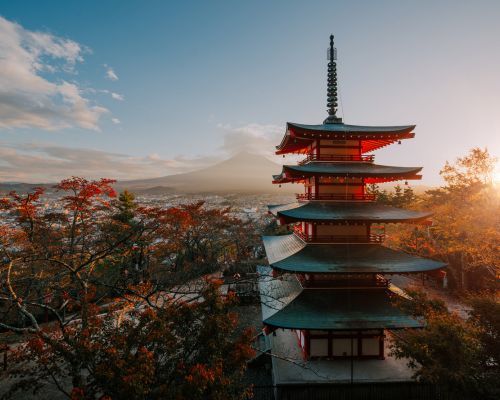Barter's Tours Best of Japan Escorted Group Tour
Duration:
12 nights
Pre-register now your interest at: 021 485 1700 or groups@travelnet.ie
Waitlist for 2026
KYOTO -> HIROSHIMA -> TAKAYAMA -> GOKAYAMA -> YUDANAKA ONSEN -> TOKYO -> HAKONE
Day 1 Kyoto
Day 2 Kyoto
Day 3 Miyajima Island
Day 4 Kyoto
Day 5 Takayama
Day 6 Gokayama
Day 7 Yudanaka Onsen
Day 8 Yudanaka Onsen
Day 9 Tokyo
Day 10 Tokyo
Day 11 Tokyo
Day 12 Hakone
Day 13 Tokyo
THE THOUSAND KYOTO - KYOTO
DELUXE HOTEL - FOUR NIGHTSArising from a Zen minimalist philosophy of ‘less is more’, the facilities and services at The Thousand Kyoto showcase simplicity and comfort rather than lavish décor. Opened in January 2019, this stylish hotel plays with light and air and greenery, drawing upon the classical ingenuity and harmony of Kyomachiya townhouses. Located in the heart of downtown and only a minute's walk from Kyoto Station, The Thousand brings all you could want to your doorstep, both traditional and modern.
HOTEL WOOD TAKAYAMA - TAKAYAMA
BOUTIQUE HOTEL - TWO NIGHTSThe HOTEL WOOD Takayama is located in the idyllic center of the old township of Takayama. During Takayama's spring festival, parade floats pass right in front of the hotel. At night, guests can enjoy a quiet evening about town unhindered by city noise. And a five-minute walk to the morning market offers pleasant exchanges with the local folk.
KANBAYASHI HOTEL SENJUKAKU - YUDANAKA ONSEN
SUPERIOR RYOKAN - TWO NIGHTS
Founded in 1928, Senjukaku was a famous rural retreat of the Meiji Era and one of the earliest hotels to introduce a mix of Japanese and Western aesthetics. It has been the favorite of many cultural figures historically. During the post-War Occupation, it was also used as a resort by the American army. Rebuilt in 1989, with its wooden beams and family treasures on display, this expansive ryokan resort very much retains the same "modern" mood as the original. Senjukaku's offerings include garden walks on site, indoor and outdoor hot spring baths and a massage service, as well as superb service from the staff and delicious and generous multi-course meals. In short, Senjukaku continues to uphold its proud tradition as a perfect country getaway.
GRAND PRINCE HOTEL NEW TAKANAWA - TOKYO
SUPERIOR HOTEL - FOUR NIGHTS
This luxurious hotel is located at the top of Zakuro-zaka street, just a few minutes' walk up the slope from the Takanawa exit of Shinagawa Station. The hotel is located in an urban resort environment that also includes convention facilities such as the Hiten banquet hall and the International Convention Center Pamir, as well as a wide variety of Japanese, Western, and Chinese restaurants and bars, both within the hotel and without. The Club Lounge celebrated a Renewal Open in late 2018, and there are live performances in the first floor bar off the expansive lobby on Friday and Saturday evenings. A complementary shuttle bus to the station is also available, and the staff are unfailingly attentive and helpful.
KYOTO
KYOTO Brimming with tradition, Kyoto is the ultimate destination for anybody who wants to soak up time-honoured Japanese culture. Home to 17 UNESCO World Heritage sites, over 1,600 Buddhist temples, and 400 Shinto shrines, this ancient city showcases the heart and soul of traditional Japan. Kyoto boasts an array of world-class gardens, majestic festivals and delicate cuisine, all of which make much of the rhythms of nature and the changing of the seasons. While on first glance visitors may find themselves struck more by the ubiquitous grid-like structure of modern metropolitan Japan, a great part of the magic of Kyoto is in picking out its treasures: sacred shrines tucked in among shopping arcades, time-honoured teahouses nestling among modern businesses and the geisha of legend sweeping down backstreets among the tourists and souvenirs. Kyoto’s charm lies in these details and whether you’re here for three days or three years, the closer you look, the more you’ll discover.
HIROSHIMA & MIYAJIMA ISLAND
Hiroshima is of course well-known for being the site of one of two atomic bombs dropped on Japan at the end of the Second World War. In the decades since, a bright and vibrant city has risen phoenix-like from the ashes. The Peace Park and Museum with visitors daily from all walks of life around the world are a poignant reminder of this source of Hiroshima's fame, and its stories of the importance of striving for fellowship over destruction are especially powerful. Other areas to visit in the city include Hiroshima Castle and the baseball stadium. The Shukkei-en garden is well worth an afternoon stroll, with a number of tea houses dotted about the grounds. No visit to Hiroshima would be complete without sampling okomiyaki, a kind of Japanese savoury pancake before your eyes using the ingredients of your choice. If you have your first okonomiyaki here, it's certainly not likely to be your last. Although Miyajima Island is a short ferry from the mainland, you will feel like you’re going back in time to a japan that stood still. Few cars and only deer to get in your way. A floating shrine and large torii gate in the water has made this island one of the most photographed islands in all of Japan.
TAKAYAMA
Mountains in Japan were recognised as the sacred dwelling places of divine spirits, and the ranges that make up the Japan Alps have a power all their own. Takayama is a delightful town in the heart of the Hida mountains, established as a castle town in the 16th century. Famous now for its old town area of narrow streets of Edo-era inns, tea houses, shops, and merchants, the town was known through the ages for the very high quality of its craftsmanship. Many of the Kyoto’s temple builders were Takayama natives, and the beauty of the shrines and temples helped give rise to its nickname of 'Little Kyoto'. Takayama's morning market on the bank of the Miyagawa River is famous and well worth a visit with its local farm produce, flowers and crafts. There are also some great old sake houses are keeping that local tradition going strong, and just on the outskirts of town, old farm houses from across the Hida region have been brought together and rebuilt beam by beam on a hillside in the Hida Folk Village. A stay in Takayama is a chance to get a taste for how things might have been before.
GOKAYAMA
Nestled along the deep gorge of Sho River, 33 Gassho-zukuri houses have been preserved in the historic villages of Gokayama including Taira and Ainokura. Now recognised as Historic Villages by UNESCO located in a mountainous region that was cut off from the rest of the world for a long period of time, these villages with their Gassho-style houses subsisted on the cultivation of mulberry trees and the rearing of silkworms. The large houses with their steeply pitched thatched roofs are the only examples of their kind in Japan. Despite economic upheavals, the villages of Ogimachi, Ainokura and Suganuma are outstanding examples of a traditional way of life perfectly adapted to the environment and people's social and economic circumstances. Cultural activities include washi paper making, a visit to a farmers house where he will perform the local dance and play a local instrument, and eat Soba Noodles, a speciality in the region.
YUDANAKA ONSEN
Yudanaka is a lovely onsen resort town located deep in the northern mountains of the Japan Alps. Famous for its proliferation of natural hot springs baths, Yudanaka attracts visitors all year round as well as during the winter months for some excellent skiing. Yudanaka is most famous for its red faced macaque 'snow' monkeys who have taken to bathing in the hot spring baths during the winter months to keep warm.
TOKYO
Everything you've heard about Tokyo is true – and it is not. For if ever there was a city that you could not confine to one definition, this would be it. The never-ending hustle and bustle of the city creates an energy that is quite contagious. One minute you may be elevated 450 metres above ground overlooking Tokyo’s sprawling metropolis, the next you might be cheering on two sumo wrestlers tackle each other in the sumo stadium. Despite the presence of people and stores everywhere, there is an order that allows things to work efficiently, seemingly against the odds. Tradition and technology stand side by side in this city that can be whatever you want to make of it.
HAKONE (DAY TRIP)
Hakone is a beautiful national park area around 50 miles west of Tokyo and just to the south of Mt Fuji, Japan's most sacred peak. The area consists of a handful of small villages and hamlets all connected by a variety of local transport, including buses, cable cars and a mountain railway that winds itself through the region's hills and valleys. Hakone has plenty to see and do, from tasting eggs boiled in volcanic waters to taking a boat trip across beautiful Lake Ashi. The outdoor sculpture park and Picasso gallery is a great place to wander around for an afternoon. Or maybe you will just sit back and relax whilst soaking in one of the many therapeutic hot spring baths that Hakone is so famous for. The other main draw to this area is the proximity to Japan's most sacred and iconic mountain, Fuji-san with its near perfect symmetrical form soaring skywards and towering over the surrounding hills. From Hakone you have one of the best chances of getting a view of Mt. Fuji from the various view points to be found throughout the area. However, be sure to have your camera at the ready; Fuji is notoriously shy and you do not want to miss that precious photo opportunity!
- Return Flights from Cork
- 12 Nights in 4 & 5 star Accommodation listed (or similar)
- Japan Tour Leader throughout
- All entrance fees, activities and meals: Breakfast daily, 4 lunches, 4 dinners
- Cultural Experiences: Geisha Meet & Greet in Kyoto, Tea Ceremony or one other cultural workshop, Sake (Rice Wine) Brewery and Tasting in Takayama, Washi Paper Making in Gokayama, Ryokan Stays including kaiseki dinner, sleeping Japanese style, and onsen (hot springs), Bullet Trains, Cooking Class in Tokyo (or similar activity of choice)
- Luxury Transport throughout on Grade A coaches
- Reserved seats on all trains
- Excellent English-Speaking Tour Guides locally (Kyoto, Hiroshima, Takayama, Gokayama, Tokyo, Hakone)
- Luggage Transfer when using trains












